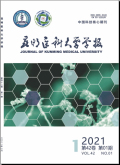昆明医科大学学报2024,Vol.45Issue(2):23-31,9.DOI:10.12259/j.issn.2095-610X.S20240204
血栓通对阿尔茨海默症模型小鼠认知功能及神经异常兴奋性的作用及其机制研究
Effects and Mechanisms of Xueshuantong on the Cognitive Function and Abnormal Neural Excitability in Mice with Alzheimer's Disease
摘要
Abstract
Objective To explore the possible effects and the underlying molecular mechanisms of xueshuantong[The main active component is panax notoginseng(PNS)]on the cognitive function and neural excitability of mice with Alzheimer's disease(AD).Methods The APP/PS1 mice were used as an animal model for AD research,at the stage when amyloid protein was not detected in mice(2 months of age).Mice in the xueshuantong group(APP/PS1+PNS)were administered by gavage once a day at a dose of 60 mg/kg for six months(for 8 months of age).The mice of the control group were given 0.9%sodium chloride(APP/PS1+Vehicle)intragastric treatment of the same volume,while the wild-type mice of the same age were given 0.9%sodium chloride intragastric treatment as the normal control group(WT+Vehicle)(15 mice in each group,n=15).After six months,the cognitive function of the mice was evaluated by the Novel Object Recognition(NOR)task and Morris Water Maze(MWM)test.The activity of BACE1,the distribution and expression of Nav1.1α,as well as the expression and enzymatic hydrolysis of Navβ2(Navβ2 full-length and Navβ2-CTF fragments)in cortex and hippocampus were detected by EEG,Western blot and cell surface biotinylation assay,respectively.Results The NOR task showed that compared with the mice in the APP/PS1+Vehicle group,the Discrimination index(DI)of mice in the APP/PS1 group was significantly increased after xueshuantong administration(P<0.05).The MWM test found that,the escape latency of the mice in the xueshuantong group was shortened followed six months in gastric administration(P<0.05),while the stay time in the target quadrant and the number of platforms significantly increased(P<0.05)after the removal of the platform.The results of EEG recording showed that xueshuantong reduced the frequency of spike-wave discharges in APP/PS1 mice(P<0.05).Furthermore,xueshuantong significantly reduced the expression of BACE1(P<0.05).In the APP+PNS group,the expression of Navβ2 full-length was increased(P<0.05),as well as corrected the abnormal distribution of Nav1.1α inside and outside of neurons(P<0.05).Conclusion Treatment with xueshuantong can significantly improve the learning and memory ability and correct the abnormal excitability of the brain in AD model mice.The mechanism may be related to the inhibition of BACE1 activity,the reduction of APP/PS1-induced excessive enzyme digestion of Navβ2,the correction of the abnormal expression and distribution of Nav1.1α in cortical and hippocampal neurons,as well as the subsequent regulation of neuronal excitability.关键词
血栓通/阿尔茨海默症/认知功能/BACE1/Navβ2酶解/Nav1.1α分布Key words
Xueshuantong/Alzheimer's disease/Cognition/BACE1/The enzymolysis of Navβ2/The distribution of Nav1.1α分类
临床医学引用本文复制引用
刘慧,严国纪,吴嘉,王丹,习杨彦彬,李珊珊..血栓通对阿尔茨海默症模型小鼠认知功能及神经异常兴奋性的作用及其机制研究[J].昆明医科大学学报,2024,45(2):23-31,9.基金项目
云南省教育厅科学研究基金资助项目(2023Y0608) (2023Y0608)
云南省科技厅基础研究专项基金资助项目(202101AT070001) (202101AT070001)

